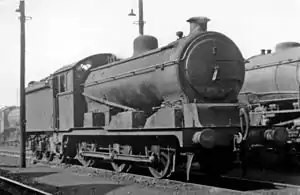| GER Class D81 LNER Class J20 | |||||||||||||||||||||||||||||||||
|---|---|---|---|---|---|---|---|---|---|---|---|---|---|---|---|---|---|---|---|---|---|---|---|---|---|---|---|---|---|---|---|---|---|
 J20 No. 4697 rests along with numerous other freight engines at March Locomotive Depot on Sunday 14 July 1946 | |||||||||||||||||||||||||||||||||
| |||||||||||||||||||||||||||||||||
| |||||||||||||||||||||||||||||||||
| |||||||||||||||||||||||||||||||||
| |||||||||||||||||||||||||||||||||
The GER Class D81 was a class of twenty-five 0-6-0 steam locomotives designed by A. J. Hill for the Great Eastern Railway. The all passed to the London and North Eastern Railway at the 1923 grouping and received the classification J20.
History
These locomotives were fitted with 20-by-28-inch (508 mm × 711 mm) cylinders and 4-foot-11-inch (1.499 m) wheels, while the Belpaire firebox-fitted boiler was identical to that fitted to the Class S69 4-6-0s. They were the most powerful 0-6-0 tender locomotive in Britain until the arrival of Oliver Bulleid's Q1 class for the Southern Railway in 1942.[1]
| Year | Order | Manufacturer | Quantity | GER Nos. | LNER Nos. | 1946 Nos. | Notes |
|---|---|---|---|---|---|---|---|
| 1920 | D81 | Stratford Works | 5 | 1270–1274 | 8270–8274 | 4675–4679 | |
| 1922 | M87 | Stratford Works | 10 | 1275–1284 | 8275–8284 | 4680–4689 | |
| 1922 | Y87 | Stratford Works | 10 | 1285–1294 | 8285–8294 | 4690–4699 | |
All were still in service at the 1923 grouping, the LNER adding 7000 to the numbers of nearly all the ex-Great Eastern locomotives, including the Class D81 locomotives. Between 1943 and 1956 the class was rebuilt with round-top fireboxes, and reclassified as J20/1.[1][2]
At nationalisation in 1948, British Railways added 60000 to their LNER numbers. They all continued in service until 1959, when the first was withdrawn; all were gone by the end of 1962.[1]
| Year | Quantity in service at start of year | Quantity withdrawn | Locomotive numbers | Notes |
|---|---|---|---|---|
| 1959 | 25 | 3 | 64675/83/88 | |
| 1960 | 22 | 9 | 64678/81–82/84–86/93–95 | |
| 1961 | 13 | 8 | 64676–77/79–80/89/92/97–98 | |
| 1962 | 5 | 5 | 64687/90–91/96/99 | |
References
- 1 2 3 4 Aldrich 1969, p. 73.
- 1 2 Baxter 2012, pp. 102–103.
- Aldrich, C. Langley (1969). The Locomotives of the Great Eastern Railway 1862–1962 (7th ed.). Wickford, Essex: C. Langley Aldrich. OCLC 30278831.
- Baxter, Bertram (2012). Baxter, David; Mitchell, Peter (eds.). British Locomotive Catalogue 1825–1923, Volume 6: Great Eastern Railway, North British Railway, Great North of Scotland Railway, Midland & Great Northern Joint Railway, remaining companies in the LNER group. Southampton: Kestrel Railway Books. ISBN 978-1-905505-26-5.
External links
- – Great Eastern Railway Society
- The Hill J20 (GER Class D81) 0-6-0 Locomotives – LNER Encyclopedia